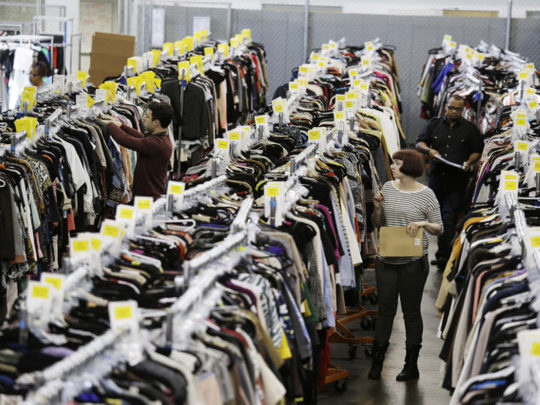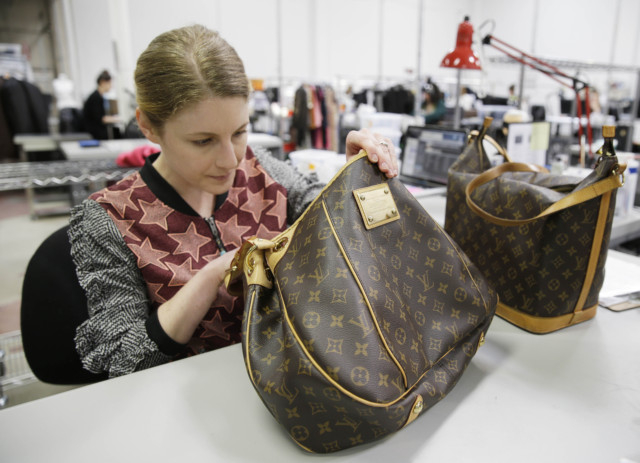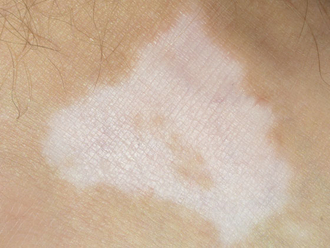
Jenna Broems shops for clothes the same way she hunts for a new car: She considers resale value.
Broems, who lives in Stamford, Connecticut, only buys brands such as Abercrombie & Fitch and 7 For All Mankind because she believes they will fetch the highest prices when she’s ready to move on.
“I’m now walking in like ‘What’s the return of this? Am I going to be able to resell?’” said Broehms, 38, a teacher who has gotten $2,500 (Dh9175) from stuff she’s resold on ThredUP, an online resale site for used clothes.
Americans increasingly are considering the resale value when they shop for everything from jeans to handbags. The habit is in part due to a growing number of websites that make it easy for shoppers to buy and resell pre-owned goods.
It’s the latest reflection of the tough economy. Buying used goods at consignment shops became popular during the recession when Americans were hurting for extra cash.
The habit has stuck during the economic recovery as people have gotten used to being able to wear the latest fashions without paying top dollar: Just as people lease a new car every couple of years so they’re always riding in style, reselling clothes is a way for Americans to trade up or splurge without spending a lot of additional cash.
The trend also is a consequence of the escalating cost of luxury. Rising prices of designer merchandise in recent years have tested the willingness of even affluent shoppers to pay full price.
The size of the resale market is tiny: about 10 per cent of overall luxury goods — including clothing, handbags, accessories and home furnishings, are sold in the aftermarket — with about one percent of pre-worn goods sold online, estimates Forrester Research’s Sucharita Mulpuru.
But data suggests it’s a fast growing area of retail: Shoppers seem to have resale value in mind. According to a survey conducted last year by market research firm The Intelligence Group’s Cassandra Report, 44 per cent of 900 shoppers between the ages of 14 and 34 think of resale value when they purchase things such as electronics, furniture and clothing.
Shannon Dolan, who lives in San Francisco, said she’ll buy a Louis Vuitton handbag over a Gucci one based on how much she believes it will command if she resells it.
“It absolutely changed the way I shop,” said Dolan, who has made $10,000 on online luxury resale marketplace TheRealReal by selling clothes. “I’m really thinking of the value and investment of some of the things I’m buying.”
Resale sites have taken note. The sites marry the discounts found on resale online king eBay with tighter controls. Luxury sites such as Portero and TheRealReal, the largest seller of authenticated luxury resale goods with business expected to reach $100 million this year, have staff to make sure designer goods are authentic.
The sites also offer a faster way to sell than consignment stores, where shoppers can wait for months to have items sold and reap no more than 50 per cent of the resale price. With the sites, items often sell within days and shoppers get as much as 80 per cent of the resale value.
Many of the sites also have their own resale guides. ThredUP is loosely calling it their own version of the Official Kelley Blue Book, referring to the online manual that offers resale values for cars. TheRealReal, which is coming out this summer with a mobile app that’s a resale guide for consumers, said its resale calculations are based on prices of the 450,000 items it has sold since its founding in 2011.
“This is a broad narrative on how people are buying things and using things,” said James Reinhart, co-founder and CEO of ThredUP, which launched as an online children’s swapping business in 2009 and morphed into a resale site two years ago.
Julie Wainwright, CEO of TheRealReal, which focuses on the top tier designer labels in fashion, accessories and jewellery, said her office fields five or six calls a day from customers wanting to know about the resale value of a brand. “People will call us before they shop, or while they’re shopping,” Wainwright said.
And the sites have all kinds of tricks of the reselling trade. For instance, TheRealReal said it doesn’t carry even some higher-end brands including Escada, St. John and Max Mara because they’ve been inconsistent or have lost buzz, and thus, don’t command high resale prices.
Conversely, the ones with the most value in pre-worn clothing and handbags are: Chanel, Hermes and Louis Vuitton. In shoes, it’s Christian Louboutin, Wainwright said.
Some analysts say the new focus on resale value could hurt sales at traditional retailers — particularly at luxury stores. “I think luxury retailers are going to run a little scared,” said Marshal Cohen, a market research analyst.
But resale sites say they can help retailers because shoppers are more willing to spend if they know they can easily resale items later. Some even are creating partnerships with traditional stores.
TheRealReal, for example, teamed up with Neiman Marcus, allowing first- time consignors to get a $50 gift card to the store. The resale site is funding the cost. Neiman Marcus declined to comment.
And some shoppers say the sites make them more comfortable about spending money in traditional stores.
Amy Fine Collins, a special correspondent for Vanity Fair magazine, sold a Chanel handbag on Therealreal.com for about $1,000, a few hundred dollars more than she originally paid for it at the store. She had the handbag for about a year.
“I don’t have to get a nose bleed at the prices the way I used to. I know there’s a strong secondary market,” she said.








